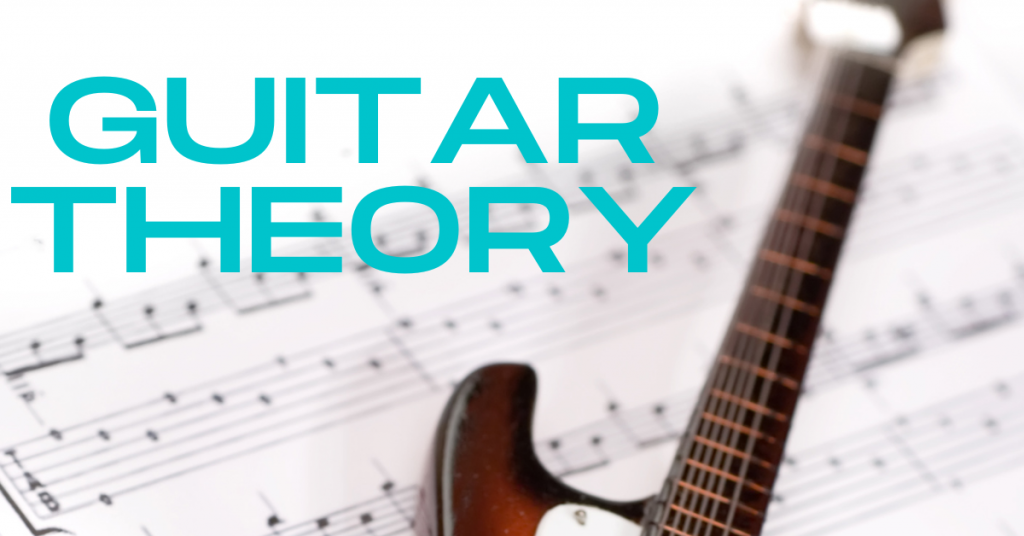Table of Contents
Do you want to understand how music works on the guitar, and why it works that way? If so, then this post is for you.
In this post I’ll answer what is guitar theory, and how you can start applying it.
Let’s dive in.
What Is Music Theory
To understand guitar theory, we first need to understand what music theory is as a whole.
Music theory is the study of how music works. The music theory you are most likely familiar with is Western music theory.
Here’s an in-depth guide about Western theory.
Music theory helps musicians communicate, and ultimately helps you understand why, how, and when you can play music.
What Is Guitar Theory?
Guitar Theory is the study of how music theory works on guitar specifically.
Some of the idiosyncrasies that exist in guitar theory are:
- Tablature
- How notes on the fretboard work
- The CAGED system
- 3 note-per-string scale systems
- Dynamic techniques (pinch harmonics, vibrato, slides, hammer-ons/pull-offs)
Those are just a few elements of theory on the guitar, and instruments similar to the guitar.
Is Music Theory Necessary for Guitar?
Music theory is not necessary for guitar, but let’s look at why or why not you would want to learn guitar theory.
The choice of whether or not to learn guitar theory is a decision to make based on your guitar or music goals.
For example, any aspiring session guitarist or freelance gigging guitarist MUST know music theory. This is because music theory is absolutely essential for communicating with other musicians, and music theory assists you in learning music faster.
You do not need to know music theory as a hobby guitarist or independent artist, however. This is because you likely have no professional goals.
And even if you have a goal to record music by yourself or with your band, it is not necessary that you know music theory, because you can write and record music with little understanding of music theory.
Why Is Guitar Theory Important?
Guitar theory is important because it helps guitarists communicate with other musicians.
Theory also helps you understand the way that music works on your guitar, which makes it easier to learn, play, improvise, and write music.
Guitar theory is bringing melody, harmony, and rhythm together to help you have an understanding of what you can and are doing on the guitar.
Guitar Scale Theory
Guitar scale theory will help you understand scales, which are consistent note patterns that contain a root note.
These groups of notes can be used to improvise, write music, understand chord progressions, and understand key signatures.
Understanding scales will help you to be a better musician, artist, and guitarist.
5 Note Scales
Many guitarists start by learning 5 note scales.
The most popular 5 note scale is the minor pentatonic scale.
This is the A minor pentatonic scale:

Major Scale And Modes
The major scale and its modes are helpful and essential to learn early in guitar theory.
The major scale will help you to understand important concepts such as:
- Where common pop, jazz, and blues chord progressions come from
- Improvisation
- Western music composition
The C Major Scale is a popular first scale to learn, because all the notes in the scale are natural notes. ( C-D-E-F-G-A-B).
You can learn more about major scale formula here.
Guitar scale resources
Here are some more resources to help you learn about guitar scales:
3 Notes Per String Major Scale (Patterns and Tabs)
Free Guitar Scales Chart for Beginners
Top 5 Essential Guitar Scales for Beginners
G Major Guitar Scale Lesson: How to Play G Major
Guitar Chord Theory
Guitar chord theory is the study of harmony as it pertains to guitar.
You can start by learning your CAGED shapes, both minor and major. These are the open chord triads that most guitarists learn as beginners. These chords are:
Major: C, A, G, E, D
Minor: A, D, E
Learn these in the open position, then learn how to move them around the fretboard. You can learn them with this post: 15 Basic Guitar Chords for Beginners (Easy and Must Know)
Construction
Chord construction is the study of intervals in chords, and how we can put them together to create different sounds.
Start by learning some basic chord formulas.
Some of the best chord formulas to start with are:
Chords will be a piece of cake once you have these down, and it will be easier to learn more formulas from there.
Progressions
Chord progressions are just an organized series of chords that are generally played consistently.
Chord progressions are usually derived from scales, and the scales help you to understand the function of each chord.
One of the most popular chord progressions is the 1-4-5 progression.
Guitar Rhythm Theory
Guitar rhythm theory is extremely important to learn, because your music can’t sound good if it doesn’t have rhythm!
Honestly, learning rhythm is an essential part of music theory. Heck, I’d argue that having a good sense of rhythm is more important than any other aspect of guitar theory.
Afterall, harmonies and melodies don’t sound good without rhythm!
Note types
Rhythms are broken down into note types. The basic note types are whole, half, quarter, and 8th notes. These note types tell us how long we are supposed to play a note.
From there you can move on to time signatures and tempos.
Time signatures
Time signature shows us how many beats, and what types of notes, are in each measure of music.
For example, 4/4 time = 4 quarter note beats per measure. The first number tells you the number of beats, and the second number shows you the note type (4= Quarter note; 8= Eighth note)
Tempo
Tempo simply tells you how fast the music is.
How Do I Learn Guitar Theory?
Learning guitar theory can be daunting at first, but you want to start by taking a few simple steps as shown below:
Start by memorizing the notes
Memorizing the notes is a piece of cake.
- Memorize the open string names. These open string notes reappear at the 12th fret on the same string, because this is the octave.
- Memorize the natural notes on low E. When you have these memorized, you will not only know where the natural notes are, but you will also be able to identify where their sharps and flats are.
- Once you have Low E Memorized, it means that you know the notes on high E as well, which means you know the note names for half of the fretboard!
- Memorize the natural notes on the A string, and you now will know the notes on HALF of the fretboard!
- Start identifying notes on the D, G, and B strings through the use of octaves on low E and A.
- Start playing specific notes, like an E note, everywhere that you can identify it on the fretboard. Say these names out loud, and do this for all of your natural notes.
- BONUS Tip: Learn to read music! That way you’ll have to memorize the notes.
Learn Rhythm Basics
Learn the basics of rhythm by practicing songs.
Learn to play in popular time signatures, such as 3/4 and 4/4.
Then work to identify the types of notes that you are playing.
And lastly, practice staying in tempo. One of the best ways to do this is by working with a drummer, or other musicians in general!
Exercises
Find guitar exercises that are meant to help you build your theoretical and technical chops.
These can be exercises for scales, techniques, phrasing, rhythm, and dynamics.
Here are some of my articles on exercises and licks.
Work on Guitar Technique
You can be the master of guitar theory, but you can’t do anything with that knowledge if you don’t work on your guitar technique!
Start by learning these right hand techniques.
From there, learn about picking techniques as a whole.
After that you can start to incorporate lead guitar techniques into your guitar playing!
Learn The Intervals of Triads
Intervals define the relationship between notes.
The simplest of intervals to learn are triad intervals. Triads are three-note chords.
Major and minor triads are the easiest triads to start with. You likely know some already, because your open chords (AKA CAGED chords/cowboy chords), are triads.
If you already know those open chords, then you just need to learn the interval names for each note in the chord!
Learn Your Major Scale
Lastly, learn your major scale. Learn the C Major scale in particular.
Learning the major scale will open up the doors to modal theory, chord progressions, composition, and improvisation.
Is Guitar Theory Easy?
Guitar theory can be as easy or hard as you want it to be.
Learning the basics of harmony, scales, and rhythm is easy.
However, Diving into advanced theoretical concepts such as polyrhythms, Messiaen modes, and advanced harmony can have a difficult, steep learning curve.
So don’t get overwhelmed with the advanced guitar theory. Start by working on the basics!
More posts related to “What is Guitar Theory?”
Ultimate Checklist of Things Every Guitarist Should Know
Best Glossary of 80+ Guitar Terms
How to Play Guitar Arpeggios: Everything You Need to Know



